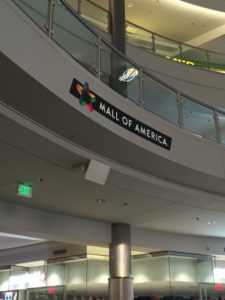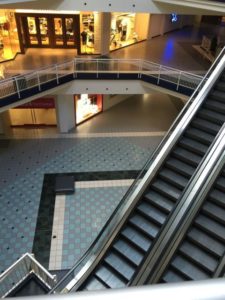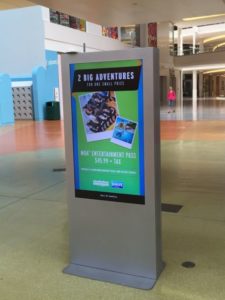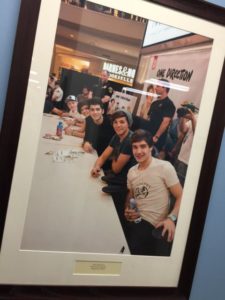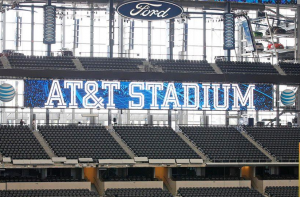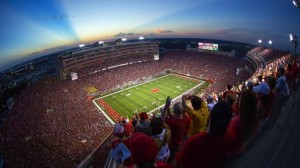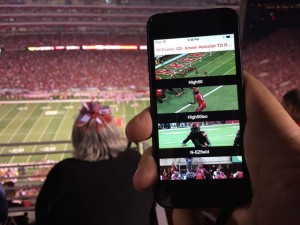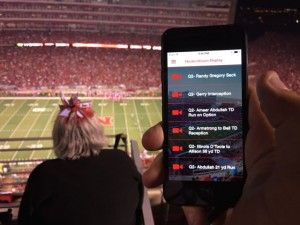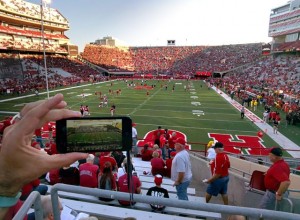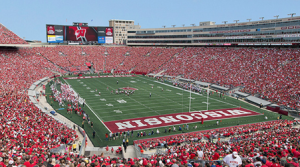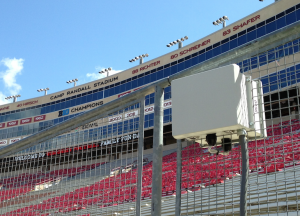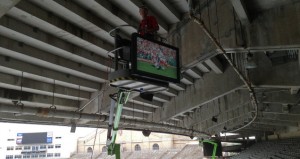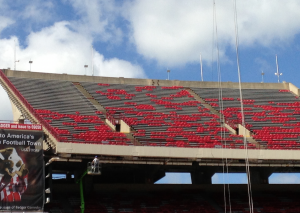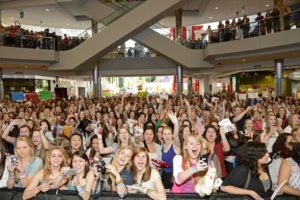
Fans greet One Direction at Mall of America. Credit: Tony Nelson (click on any photo for a larger image)
That’s what Minnesota’s Mall of America did, not by finding a service that sells such information, but by investing in a massive and complex Wi-Fi network, designed and deployed by AmpThink using Cisco gear. And the service is free for Mall visitors. While being an attractive guest feature, the service simultaneously provides the Mall with enough data to fill digital warehouses with information about what people do both online and in the real world while on the property.
According to Janette Smrcka, IT director for Mall of America, though the Mall is only at the start of its data analysis program, it is already seeing interesting results that will likely help the Mall better connect with its visitors and, in all likelihood, improve business results for Mall tenants. A recent month-long sampling of customer behavior data gave the Mall a tremendous amount of insight on how activities such as promotions and events affect visitor behavior, information the Mall wouldn’t have had without its Wi-Fi network.
“We’re just at the beginning of being able to use all of this valuable data and translate it into actionable information,” said Smrcka in an interview at Mall of America, located in Bloomington, nine miles south of Minneapolis.
Almost a Super Bowl of data every week
How much data are we talking about? In the world of stadium networks, the most recent Super Bowl at Levi’s Stadium in Santa Clara, Calif. set a single-day record with 26 terabytes of wireless data used – 15.9 TB on cellular networks and 10.1 TB on the stadium Wi-Fi. At Mall of America, from the launch of their Wi-Fi network during Thanksgiving weekend last year until May 2016, nearly 320,000 unique Mall visitors connected to the network, using a total of 486 TB of traffic – almost a Super Bowl of data per week.
While the Mall might not match the single-day crush of a Super Bowl, the steady stream of visitors (Mall officials estimate that the six million square-foot facility sees an average of 109,000 visitors on weekdays and 160,000 on weekends) produces some staggering numbers. According to a recent public presentation about the network, Mall of America claimed that one month of Wi-Fi usage on its network equaled a full year of Wi-Fi activity on an NBA-sized stadium network.According to Smrcka, the Mall knew it needed Wi-Fi connectivity as a table stakes amenity, but it was mindful of fitting performance to price, while achieving return on investment justification in the process.
“We knew we needed something but the challenge was the cost,” Smrcka said. “We knew we couldn’t charge for the service.” Smrcka also said the Mall has seen other malls try and fail with initial Wi-Fi deployments due to subpar service, prompting guest disdain.
“We’ve seen some of our peers put Wi-Fi in, and not do it very well, and get lots of complaints,” Smrcka said. “It’s like airport Wi-Fi. Sure it’s there, but just try using it.”
With AmpThink, Mall of America found a partner who knew the need for high-quality deployments. The design and install company has been behind the Wi-Fi networks at several Super Bowls, as well as recent networks built in stadiums like Kyle Field at Texas A&M and US Bank Stadium in Minneapolis.
However, this massive Wi-Fi network, along with the unique challenges of implementing it at the Mall, also needed the elusive component of return on investment.Not easy to build inside a mall
On a recent early morning tour of the Mall, AmpThink president Bill Anderson showed Mobile Sports Report some of the challenges inherent to one of the world’s biggest shopping venues. For starters, there was the need for custom enclosures that fit with the facility’s overall aesthetics as well as cutting through double firewalls (the real kind of firewalls, not the software kind) to keep safety codes intact.
To cover one of the Mall’s more unique spaces, the 7-acre theme park in the center of the facility, AmpThink had to design and build enclosures that look like big lollipops. This “Wi-Fi ball on a stick” design fit the park’s design aesthetics while providing coverage in and around the various rides and amusement spaces. AmpThink also figured out how to fit a Wi-Fi AP inside digital sign kiosks, so the kiosks could connect to the network and therefore the Cisco StadiumVision system for digital display management. In many places, the APs included beacons inside, setting up the network for device proximity capabilities.
From an RF perspective, Anderson said one of the toughest challenges was keeping interference to a minimum between APs on different floors of the multi-level mall. Another large challenge was simply the logistics of construction, with separate scheduling needed for the many hundreds of Mall tenants.
“We own the space above their ceilings, and would need to get in the stores to run cable through,” said Smrcka. Coordinating construction was a challenge at times, like when teenage clerks didn’t relay scheduling messages to their store managers, further complicated by the need to have security officers present to keep an eye on inventory.Anderson said that AmpThink deployment teams also needed to make sure they cleaned up after putting in APs, as any drywall dust found on store facades could result in complaints from store owners. Despite the extra hurdles, deployment of the network, composed of more than 600 APs, started in July of last year and launched just before Thanksgiving. Then the data started pouring in. Now, what to do with all that information?
Putting students to work
To help figure out how to best use the stream of information coming its way, the Mall conducted a study of its data in a partnership with graduate students at the Carlson Analytics Lab at the University of Minnesota’s Carlson School of Management. By mapping visitor behavior using Wi-Fi and beacon activity – tracking where shoppers arrived, where they walked and how long they spent in different areas of the Mall – Mall of America and the student researchers were able to uncover interesting stats on things like in-mall promotions, events and store appeal.
According to the Mall’s presentation at the recent SEAT Conference in Las Vegas, one analysis showed that if visitors were offered free admission to the amusement park, they actually spent 40 percent of their time at the Mall somewhere other than the amusement park — a sign that free amusement park entry could spur more shopping. The analysis also showed that during events at the Mall – according to the Mall, it hosts more than 400 special events a year – visitors stayed at the Mall on average 1.4 times longer than visitors who did not attend an event. The Mall also found out that 39 percent of event attendees visited the Mall’s food courts, compared to 25 percent of non-event visitors.During its presentation, the Mall also showed screenshots of interactive “heat maps” showing exactly where visitors entered, where they walked, and how long they stayed. This information was gathered by the Wi-Fi AP beacons, which allowed for accurate device location tracking. With such information at their fingertips, the Mall sees a future where the network helps initiate new features for assisted shopping and custom experiences for visitors without resorting to historic feedback systems like surveys or focus groups.
Data driving the future
“This data is golden when it comes to describing shopper behavior,” said Smrcka, who also talked about the deployment at the SEAT Conference in Las Vegas. Shopper surveys, she said, have proven to sometimes not be reliable, and “who has the time to sit in a focus group for hours?”
This information enhances other Mall guest behavior and experience initiatives. “We already have a social media command team watching geo-located social media posts,” Smrcka said. They also employ a text messaging system, which visitors use to send messages to customized numbers to communicate if a bathroom needs servicing, set a reminder for their parking spot, or to find out where the closest gelato stand is.And while Mall of America, like other bricks and mortar retailers, competes every day against online shopping, Smrcka said there are plenty of people who still want to see and feel the goods they are purchasing. Mall of America plans to use their Wi-Fi network’s data to make the guest experience even better and study the feasibility of possible future services like personal shopping, valet parking, curbside pickup and home delivery.
Moreover, Smrcka and her team can better segment and target its visitors and their entertainment, dining and shopping needs.
“What we’re able to do [from analytics] is still changing from month to month,” Smrcka said. “But the data really empowers a team like ours.”
